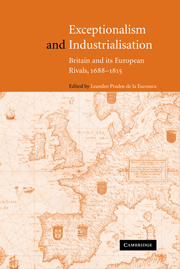Book contents
- Frontmatter
- Contents
- List of tables and figures
- List of contributors
- Acknowledgements
- Introduction: Was British industrialisation exceptional?
- Part I The origins of British primacy
- Part II Agriculture and industrialisation
- Part III Technological change
- Part IV Institutions and growth
- Part V War and Hegemony
- Conclusions
- Institutional change and British supremacy, 1650–1850: some reflections
- Laudatio patritii. Patrick O'Brien and European economic history
- References
- Index
Institutional change and British supremacy, 1650–1850: some reflections
Published online by Cambridge University Press: 04 December 2009
- Frontmatter
- Contents
- List of tables and figures
- List of contributors
- Acknowledgements
- Introduction: Was British industrialisation exceptional?
- Part I The origins of British primacy
- Part II Agriculture and industrialisation
- Part III Technological change
- Part IV Institutions and growth
- Part V War and Hegemony
- Conclusions
- Institutional change and British supremacy, 1650–1850: some reflections
- Laudatio patritii. Patrick O'Brien and European economic history
- References
- Index
Summary
Introduction
We have all long been fascinated with understanding the ‘European Miracle’ and more specifically the ‘British Miracle’ of the seventeenth and eighteenth centuries. The growth of Britain from a small island with internal discord to become Europe's and the world's leading economic and political power by the start of the nineteenth century has had many explanations, reflecting in some measure the present-day views of economists, historians and other scholars. In the years after 1500, western European per capita incomes grew at a more rapid rate than did those in the rest of the world. Within Europe the Netherlands and Britain grew most rapidly before 1820, but at rates about one-fifth of the British rate between 1820 and 1870. With this early, but relatively slow, start it was in the period 1820–70 that British growth accelerated and its position improved vis-à-vis the rest of Europe, even western Europe, and the rest of the world. From a relative per capita income twice that of the rest of the world in 1700, the UK relative rose to 2.6 in 1820, and then to 3.7 in 1870. Thus, while British growth began to accelerate after 1700, it was not until the middle of the nineteenth century that Britain developed its large lead. Not only did the British metropolis develop economically, but this growth occurred with the acquisition of an extensive overseas empire consisting of a rather diverse set of colonies.
- Type
- Chapter
- Information
- Exceptionalism and IndustrialisationBritain and its European Rivals, 1688–1815, pp. 261 - 282Publisher: Cambridge University PressPrint publication year: 2004
- 1
- Cited by

